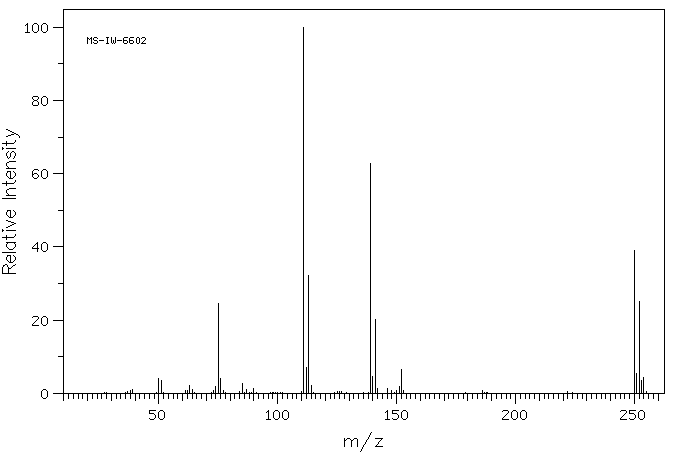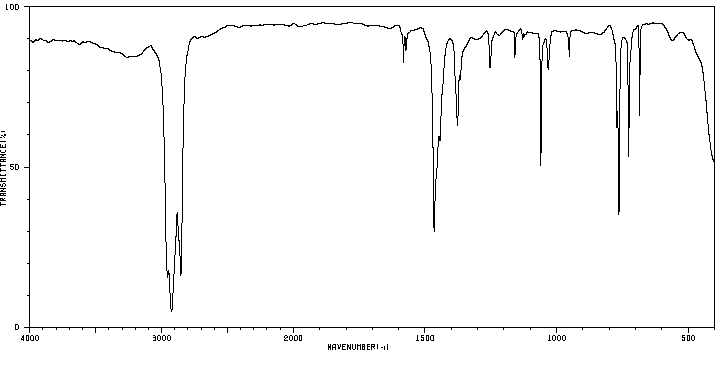(E)-bis(2-chlorophenyl)diazene | 49795-06-4
中文名称
——
中文别名
——
英文名称
(E)-bis(2-chlorophenyl)diazene
英文别名
(E)-1,2-bis(2-chlorophenyl)diazene;(E)-1,2-di-o-chlorophenyldiazene;E-1,2-bis(2-chlorophenyl)diazene;trans-2,2'-dichloroazobenzene;2,2'-dichloroazobenzene;(E)-bis-(2-chloro-phenyl)-diazene
CAS
49795-06-4
化学式
C12H8Cl2N2
mdl
——
分子量
251.115
InChiKey
FIQUJBRQBIUISO-FOCLMDBBSA-N
BEILSTEIN
——
EINECS
——
-
物化性质
-
计算性质
-
ADMET
-
安全信息
-
SDS
-
制备方法与用途
-
上下游信息
-
文献信息
-
表征谱图
-
同类化合物
-
相关功能分类
-
相关结构分类
物化性质
-
熔点:119.7-121.3 °C
-
沸点:376.9±27.0 °C(Predicted)
-
密度:1.47 g/cm3
计算性质
-
辛醇/水分配系数(LogP):5.41
-
重原子数:16.0
-
可旋转键数:2.0
-
环数:2.0
-
sp3杂化的碳原子比例:0.0
-
拓扑面积:24.72
-
氢给体数:0.0
-
氢受体数:2.0
上下游信息
-
上游原料
中文名称 英文名称 CAS号 化学式 分子量 1-叠氮基-2-氯苯 1-azido-2-chlorobenzene 3296-07-9 C6H4ClN3 153.571 —— Azoxybenzene, 2,2'-dichloro- 13556-84-8 C12H8Cl2N2O 267.114 -
下游产品
中文名称 英文名称 CAS号 化学式 分子量 —— Azoxybenzene, 2,2'-dichloro- 13556-84-8 C12H8Cl2N2O 267.114
反应信息
-
作为反应物:描述:(E)-bis(2-chlorophenyl)diazene 在 palladium diacetate 、 [双(三氟乙酰氧基)碘]苯 作用下, 以 1,2-二氯乙烷 为溶剂, 反应 36.0h, 以34%的产率得到(E)-3-chloro-2-[(2-chlorophenyl)diazenyl]phenol参考文献:名称:钯催化不对称偶氮酚的氧化合成摘要:报道了直接的钯催化的偶氮苯的氧化羟基化。所开发的方法可以耐受各种官能团,并允许在温和条件下以良好或优异的收率合成各种不对称的偶氮苯酚。还通过原位生成PIFA研究了一种补充程序。这项研究代表了从简单的偶氮芳烃开始合成邻-羟基偶氮苯的第一种通用方法。DOI:10.1021/acs.joc.5b02614
-
作为产物:参考文献:名称:偶氮和偶氮化合物的聚合配对电化学合成:对反应机理的深入了解摘要:开发了一种收敛配对电化学方法,用于从相应的硝基芳烃开始合成偶氮和偶氮化合物。我们提出了一种独特的偶氮和偶氮化合物电合成机制。我们发现阳极和阴极反应都负责这些化合物的合成。偶氮和偶氮衍生物的合成已在未分隔的电池中成功进行,使用碳棒电极,在室温下通过恒流电解。DOI:10.1021/acs.orglett.1c02304
文献信息
-
Rhenium-Catalyzed [4 + 1] Annulation of Azobenzenes and Aldehydes via Isolable Cyclic Rhenium(I) Complexes作者:Xiaoyu Geng、Congyang WangDOI:10.1021/acs.orglett.5b00938日期:2015.5.15The first Re-catalyzed [4 + 1] annulation of azobenzenes with aldehydes was developed to furnish 2H-indazoles via isolable and characterized cyclic ReI-complexes. For the first time, the acetate-acceleration effect is showcased in Re-catalyzed C–H activation reactions. Remarkably, mechanistic studies revealed an irreversible aldehyde-insertion step, which is in sharp contrast to those of previous Rh-
-
A Concerted Transfer Hydrogenolysis: 1,3,2-Diazaphospholene-Catalyzed Hydrogenation of NN Bond with Ammonia-Borane作者:Che Chang Chong、Hajime Hirao、Rei KinjoDOI:10.1002/anie.201400099日期:2014.3.241,3,2‐diazaphospholenes catalyze metal‐free transfer hydrogenation of a NN double bond using ammonia–borane under mild reaction conditions, thus allowing access to various hydrazine derivatives. Kinetic and computational studies revealed that the rate‐determining step involves simultaneous breakage of the BH and NH bonds of ammonia–borane. The reaction is therefore viewed as a concerted type of
-
Cage Encapsulated Gold Nanoparticles as Heterogeneous Photocatalyst for Facile and Selective Reduction of Nitroarenes to Azo Compounds作者:Bijnaneswar Mondal、Partha Sarathi MukherjeeDOI:10.1021/jacs.8b07767日期:2018.10.3fine-dispersed cage anchored AuNPs (Au@OC1R) have been finally used as potential heterogeneous photocatalyst for very facile and selective conversion of nitroarenes to respective azo compounds at ambient temperature in just 2 h reaction time. Exceptional chemical stability and reusability without any agglomeration of AuNPs even after several cycles of use are the potential features of this material. The composite离散的纳米级有机笼 (OC1R) 由基于吩噻嗪的三醛通过动态亚胺键形成和还原胺化处理与手性 1,2-环己二胺结构单元处理合成。笼状化合物已通过几种光谱方法进行表征,这些方法主张OC1R具有通过[2 + 3]自组装亚胺缩合然后亚胺还原形成的三棱柱形状。这种新设计的笼子具有芳香壁和多孔内部,装饰有两个环状硫醚和三个邻二胺部分,适合结合金离子以设计超细金纳米粒子 (AuNPs) 的受控成核和稳定化。笼子的功能化受限口袋已用于通过封装 Au(III) 离子来控制合成具有窄尺寸分布的 AuNP。电感耦合等离子体质谱 (ICP-MS) 分析表明,复合 Au@OC1R 具有非常高的金负载量(~68 wt%)。不同的是,在没有笼子的情况下金盐的还原产生无结构的附聚物。精细分散的笼状锚定金纳米粒子(Au@OC1R)最终被用作潜在的多相光催化剂,用于在环境温度下在仅 2 小时的反应时间内非常容易和选择性地将硝
-
Electrosynthesis of Azobenzenes Directly from Nitrobenzenes作者:Yanfeng Ma、Shanghui Wu、Shuxin Jiang、Fuhong Xiao、Guo‐Jun DengDOI:10.1002/cjoc.202100470日期:2021.12The electrochemical reduction strategy of nitrobenzenes is developed. The chemistry occurs under ambient conditions. The protocol uses inert electrodes and the solvent, DMSO, plays a dual role as a reducing agent. Its synthetic value has been demonstrated by the highly efficient synthesis of symmetric, unsymmetric and cyclic azo compounds.
-
Dimerization of anilines and benzylamines with mercury(II) oxide-iodine reagent作者:Kazuhiko Orito、Takahiro Hatakeyama、Mitsuhiro Takeo、Shiho Uchiito、Masao Tokuda、Hiroshi SuginomeDOI:10.1016/s0040-4020(98)00461-x日期:1998.7similar treatment of benzylamines and benzhydrylamine gave N-benzylidenebenzylamines and N-benzhydrylidenebenzhydrylamine, respectively. α-Alkyl-substituted benzylamines gave diazenes and the corresponding phenyl ketones, competitively. An azine was obtained by interaction with the reagent of a benzylamine carrying an electron-withdrawing substituent at the α position, such as ethyl phenylglycinate.
表征谱图
-
氢谱1HNMR
-
质谱MS
-
碳谱13CNMR
-
红外IR
-
拉曼Raman
-
峰位数据
-
峰位匹配
-
表征信息
同类化合物
黑洞猝灭剂-2,BHQ-2ACID
麦角甾烷-6-酮,2,3,22,23-四羟基-,(2a,3a,5a,22S,23S,24S)-
颜料橙61
阿利新黄GXS
阳离子红X-GTL
阳离子红5BL
阳离子橙RN
阳离子橙GLH
间甲基红
镨(3+)丙烯酰酸酯
镍酸酯(1-),[3-羟基-4-[(4-甲基-3-硫代苯基)偶氮]-2-萘羧酸根(3-)]-,氢
锂3-({4-[(4-羟基苯基)偶氮]-5-甲氧基-2-甲基苯基}偶氮)苯磺酸酯
钴,[二[m-[[1,2-二苯基-1,2-乙二酮1,2-二(肟酸根-kO)](2-)]]四氟二硼酸根(2-)-kN1,kN1',k2,kN2']-,(SP-4-1)-
钠5-氯-2-羟基-3-[(2-羟基-4-{[(4-甲基苯基)磺酰基]氧基}苯基)偶氮]苯磺酸酯
钠5-[[3-[[5-[[4-[[[4-[(4,5-二氢-3-甲基-5-氧代-1H-吡唑-4-基)偶氮]苯基]氨基]羰基]苯基]偶氮]-2,4-二羟基苯基]偶氮]-4-羟基苯基]偶氮]水杨酸盐
钠4-[(4-氨基苯基)偶氮]苯甲酸酯
钠4-[(4-{[4-(二乙基氨基)苯基]偶氮}苯基)偶氮]苯磺酸酯
钠4-[(4-{[2-羟基-5-(2-甲基-2-丙基)苯基]偶氮}苯基)偶氮]苯磺酸酯
钠4-({3-甲氧基-4-[(4-甲氧基苯基)偶氮]苯基}偶氮)苯磺酸酯
钠3-[4-(2-羟基-5-甲基-苯基)偶氮苯基]偶氮苯磺酸酯
钠3-({5-甲氧基-4-[(4-甲氧基苯基)偶氮]-2-甲基苯基}偶氮)苯磺酸酯
钠3-({4-[(4-羟基-2-甲基苯基)偶氮]-3-甲氧基苯基}偶氮)苯磺酸酯
金莲橙O
重氮基烯,苯基[4-(三氟甲基)苯基]-
重氮基烯,二[4-(1-甲基乙基)苯基]-,(Z)-
重氮基烯,二[4-(1-甲基乙基)苯基]-,(E)-
重氮基烯,[4-[(2-乙基己基)氧代]-2,5-二甲基苯基](4-硝基苯基)-
重氮基烯,1,2-二(4-丙氧基苯基)-,(1E)-
重氮基烯,(2-氯苯基)苯基-
酸性金黄G
酸性棕S-BL
酸性媒染棕
酸性媒介棕6
酸性媒介棕48
酸性媒介棕4
酸性媒介棕24
邻氨基偶氮甲苯
达布氨乙基甲硫基磺酸盐
赛甲氧星
茴香酸盐己基
茜素黄 R 钠盐
苯重氮化,2-甲氧基-5-甲基-4-[(4-甲基-2-硝基苯基)偶氮]-,氯化
苯酰胺,4-[4-(2,3-二氢-1,4-苯并二噁英-6-基)-5-(2-吡啶基)-1H-咪唑-2-基]-
苯酚,4-(1,1-二甲基乙基)-2-(苯偶氮基)-
苯酚,2-甲氧基-4-[(4-硝基苯基)偶氮]-
苯胺棕
苯胺,4-[(4-氯-2-硝基苯基)偶氮]-
苯磺酸,3,3-6-(4-吗啉基)-1,3,5-三嗪-2,4-二基二亚氨基2-(乙酰基氨基)-4,1-亚苯基偶氮二-,盐二钠
苯磺酸,2-[(4-氨基-2-羟基苯基)偶氮]-
苯甲酸,5-[[4-[(乙酰基氨基)磺酰]苯基]偶氮]-2-[[3-(三氟甲基)苯基]氨基]-(9CI)








